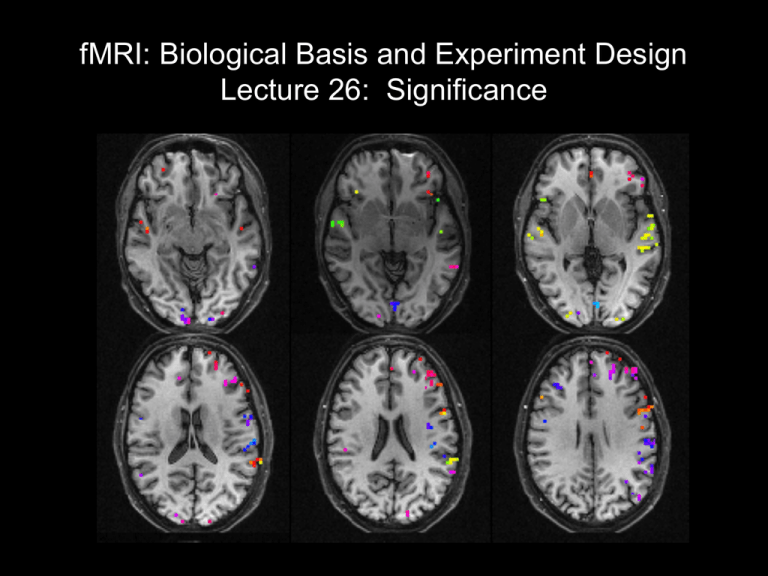fMRI: Biological Basis and Experiment Design Lecture 26: Significance
advertisement

fMRI: Biological Basis and Experiment Design Lecture 26: Significance • Review of GLM results • Baseline trends • Block designs; Fourier analysis (correlation) • Significance and confidence intervals Noise in brains • Spatially correlated – Big vessels – Blurring in image – Neural activity is correlated • Temporally correlated – Noise processes have memory Noise in brains: spatial correlation • Spatial correlation: use one voxel as "seed" (template) – calculate correlation with neighbors (whole brain, if you have time ...) – Basis of functional connectivity Seed voxel Picking a voxel not significantly modulated by the stimulus, we still see correlations locally Correlation is not seen in white matter; organized in gray matter Picking a voxel in white matter, we still few correlated voxels either locally or globally. Picking a voxel significantly modulated by the stimulus, we still see correlations all over Noise in brains: temporal correlation Uncorrelated noise Time domain Frequency domain Smoothed noise Noise in brains: temporal correlation • Drift and long trends have biggest effects Noise in brains: temporal correlations • (Missing slides, where I took 8 sample gray matter pixels and 8 sample white matter pixels and looked at the autorcorrelation function for each pixel) Noise in brains: temporal correlation • How to detect? – Auto correlation with varying lags – FT: low temporal frequency components indicate temporal structure • How to compensate? – "pre-whiten" data (same effect as low-pass filtering?) – Reduce degrees of freedom in analysis. Fourier analysis • Correlation with basis set: sines and cosines • Stimulus-related component: amplitude at stimulusrelated frequency (can be z-scored by full spectrum) • Phase of stimulus-related component has timing information Fourier analysis of block design experiment Time from stim onset: 0s 12s 24s Fourier analysis of block design experiment Fourier analysis of block design experiment Significance • Which voxels are activated? Significance: ROI-based analysis • ICE15.m shows a comparison of 2 methods for assigning confidence intervals to estimated regression coefficients – Bootstrapping: repeat simulation many times (1000 times), and look at the distribution of fits. A 95% confidence interval can be calculated directly from the standard deviation of this distribution (+/- 1.96*sigma) – Matlab’s regress.m function, which relies the assumption of normally distributed independent noise • The residuals after the fit are used to estimate the distribution of noise • The standard error of the regression weights is calculated, based on the standard deviaion of the noise (residuals), and used to assign 95% confidence intervals. • When the noise is normal and independent, these two methods should agree Multiple comparisons • How do we correct for the fact that, just by chance, we could see as many as 500 false positives in our data? – Bonferonni correction: divide desired significance level (e.g. p < .05) by number of comparisons (e.g. 10,000 voxels) - display only voxels significant at p < .000005. • Too stringent! – False Discovery Rate: currently implemented in most software packages • “FDR controls the expected proportion of false positives among suprathreshold voxels. A FDR threshold is determined from the observed p-value distribution, and hence is adaptive to the amount of signal in your data.” (Tom Nichols’ website) • See http://www.sph.umich.edu/~nichols/FDR/





